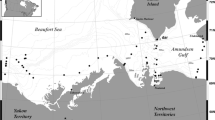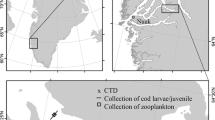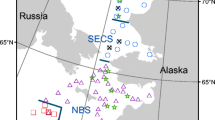Abstract
In the early 1990s, the Atlantic cod (Gadusmorhua) population on the Newfoundland and Labrador shelf declined dramatically, leading to a fishing moratorium in 1992. The Northern cod population has not fully recovered, possibly due to the simultaneous population collapse of an important prey type, capelin (Mallotus villosus), which migrates from the continental shelf into coastal Newfoundland to spawn every summer. Our objective was to test whether capelin availability influenced short-term dietary shifts of cod while inshore on the northeast Newfoundland coast. We quantify the dietary composition and relative abundance and biomass of prey types in cod stomachs sampled weekly or bi-weekly throughout July-August 2017 and 2018. Survey-based acoustic estimates of capelin biomass and the timing of spawning in the study area revealed that peak capelin biomass was five times higher (0.239 g/m2) and two weeks earlier (July 28) during 2018 relative to 2017 (0.048 g/m2, August 9). Cod stomachs were ~ 10 times more likely to contain capelin during 2018 relative to 2017. As capelin availability increased throughout each summer, cod shifted from a high diversity diet of lower-quality invertebrate prey (e.g., shrimp, crab) to a low diversity, capelin-dominated diet, whereby capelin presence, abundance and biomass increased. These findings indicate that capelin remains a primary prey type of cod in inshore waters during their summer growing season, but dietary proportions of capelin vary with their availability. As low dietary proportions of capelin are associated with reduced body condition and reproductive potential in cod, findings support the need for an integrated capelin-cod management approach.




Similar content being viewed by others
Data availability
The data sets used during the current study are available from the corresponding author upon reasonable request.
References
Baillie SM, Jones IL (2004) Response of Atlantic puffins to a decline in capelin abundance at the Gannet Islands, Labrador. Waterbirds 27:102–111
Bearhop S, Adams CE, Waldron S et al (2004) Determining trophic niche width: A novel approach using stable isotope analysis. J Anim Ecol 73:1007–1012
Bishop CA, Murphy EF, Baird JW, Rose GA (1993) An assessment of the cod stock in NAFO divisions 2J + 3KL. NAFO SCR Doc 93/86 No. N2271
Bryant R, Jones IL, Hipfner JM (1999) Responses to changes in prey availability by common murres and thick-billed murres at the Gannet Island, Labrador. Can J Zool 77:1278–1287
Buren AD, Koen-Alonso M, Pepin P et al (2014) Bottom-up regulation of capelin, a keystone forage species. PLoS One 9:1–11
Buren AD, Murphy HM, Adamack AT et al (2019) The collapse and continued low productivity of a keystone forage fish species. Mar Ecol Prog Ser 616:155–170
Campana SE (2004) Photographic atlas of fish otoliths of the Northwest Atlantic Ocean. NRC Research Press, Ottawa
Carscadden JE, Montevecchi WA, Davoren GK, Nakashima BS (2002) Trophic relationships among capelin (Mallotus villosus) and seabirds in a changing ecosystem. ICES J Mar Sci 59:1027–1033
Carvalho PC, Davoren GK (2019) Niche dynamics of sympatric non-breeding shearwaters under varying prey availability. IBIS (Lond 1859). https://doi.org/10.1111/ibi.12783
Crook KA, Maxner E, Davoren GK (2017) Temperature-based spawning habitat selection by capelin (Mallotus villosus) in Newfoundland. ICES J Mar Sci 74:1622–1629
Daan N (1973) A quantitative analysis of the food intake of North Sea cod, Gadus morhua. Netherlands J Sea Res 6:479–517
Dalsgaard J, St. John M, Kattner G et al (2003) Fatty acid trophic markers in the pelagic marine environment. Adv Mar Biol 46:225–340
Davoren GK, Montevecchi WA (2003) Signals from seabirds indicate changing biology of capelin stocks. Mar Ecol Prog Ser 258:253–261
Davoren GK, Anderson JT, Montevecchi WA (2006) Shoal behaviour and maturity relations of spawning capelin (Mallotus villosus) off Newfoundland: Demersal spawning and diel vertical movement patterns. Can J Fish Aquat Sci 63:268–284
Davoren GK, Penton P, Burke C, Montevecchi WA (2012) Water temperature and timing of capelin spawning determine seabird diets. ICES J Mar Sci 69:1234–1241
Dempson JB, Shears M, Bloom M (2002) Spatial and temporal variability in the diet of anadromous Arctic charr, Salvelinus alpinus, in northern Labrador. Environ Biol Fishes 64:49–62
DFO (2019) Assessment of 2J3KL capelin in 2018. CSAS Sci Advis Rep 2019/048
Fudge SB, Rose GA (2008) Life history co-variation in a fishery depleted Atlantic cod stock. Fish Res 92:107–113
Garrison LP (2000) Spatial and dietary overlap in the Georges Bank groundfish community. Can J Fish Aquat Sci 57:1679–1691
Gulka J, Davoren GK (2019) High individual flexibility in the foraging behavior of a marine predator, the common murre. Mar Biol 166:1–16
Gulka J, Carvalho PC, Jenkins E et al (2017) Dietary niche shifts of multiple marine predators under varying prey availability on the northeast Newfoundland coast. Front Mar Sci 4:1–11
Gulka J, Ronconi RA, Davoren GK (2019) Spatial segregation contrasting dietary overlap: niche partitioning of two sympatric alcids during shifting resource availability. Mar Biol 166:1–17
Hutchings JA (1999) Influence of growth and survival costs of reproduction on Atlantic cod, Gadus morhua, population growth rate. Can J Fish Aquat Sci 56:1612–1623
Hutchinson GE (1957) Concluding remarks. Cold Spring Harb Symp Quant Biol 22:415–427
Hyslop EJ (1980) Stomach contents analysis-a review of methods and their application. J Fish Biol 1741:1–429
Kindsvater HK, Palkovacs EP (2017) Predicting eco-evolutionary impacts of fishing on body size and trophic role of Atlantic cod. Copeia 105:475–482
Knickle DC, Rose GA (2014) Dietary niche partitioning in sympatric gadid species in coastal Newfoundland: Evidence from stomachs and C-N isotopes. Environ Biol Fishes 97:343–355
Krumsick KJ, Rose GA (2012) Atlantic cod (Gadus morhua) feed during spawning off Newfoundland and Labrador. ICES J Mar Sci 69:1701–1709
Lawson GL, Rose GA (2000) Small-scale spatial and temporal patterns in spawning of Atlantic cod (Gadus morhua) in coastal Newfoundland waters. Can J Fish Aquat Sci 1024:1011–1024
Lawson JW, Magalhaes AM, Miller EH (1998) Important prey species of marine vertebrate predators in the northwest Atlantic: proximate composition and energy density. Mar Ecol Prog Ser 164:13–20
Lilly GR (1987) Interactions between Atlantic cod (Gadus morhua) and capelin (Mallotus villosus) off Labrador and Eastern Newfoundland: a review. Can Tech Rep Fish Aquat Sci 1567:1–37
Lilly GR, Fleming AM (1981) Size relationships in predation by Atlantic cod, Gadus morhua, on capelin, Mallotus villosus, and sand lance, Ammodytes dubius, in the Newfoundland area. NAFO Sci Coun Stud 1:41–45
Link JS, Sherwood GD (2019) Feeding, growth, and trophic ecology. In: Rose G (ed) Atlantic cod: A bio-ecology. Wiley-Blackwell, Hoboken, pp 219–286
Macarthur RH, Pianka ER (1966) On optimal use of a patchy environment. Am Nat 100:603–609
Marshall CT, Yaragina NA, Lambert Y, Kjesbu OS (1999) Total lipid energy as a proxy for total egg production by fish stocks. Nature 402:288–290
Mehl S, Sunnanå K (1991) Changes in growth of Northeast Arctic cod in relation to food consumption in 1984–1988. ICES Mar Sci Symp 193:109–112
Mello L, Rose G (2005) Seasonal growth of Atlantic cod: effects of temperature, feeding and reproduction. J Fish Biol 67:149–170
Methven DA, Piatt JF (1989) Seasonal and annual variation in the diet of Atlantic cod (Gadus morhua) in relation to the abundance of capelin (Mallotus villosus) off eastern Newfoundland, Canada. ICES J Mar Sci 45:223–225
Montevecchi WA (2007) Binary dietary responses of northern gannets Sula bassana indicate changing food web and oceanographic conditions. Mar Ecol Prog Ser 352:213–220
Montevecchi WA, Piatt J (1984) Composition and energy contents of inshore spawning capelin (Mallotus villosus): Implications for seabird predators. Comp Biochem Physiol 78:15–20
Montevecchi W, Gerrow K, Buren A et al (2019) Pursuit-diving seabird endures regime shift involving a three-decade decline in forage fish mass and abundance. Mar Ecol Prog Ser 627:171–178
Mullowney DRJ, Rose GA (2014) Is recovery of northern cod limited by poor feeding? The capelin hypothesis revisited. ICES J Mar Sci 71:784–793
Murphy HM, Pepin P, Robert D (2018) Re-visiting the drivers of capelin recruitment in Newfoundland since 1991. Fish Res 200:1–10
Myers RA, Mertz G, Bishop CA (1993) Cod spawning in relation to physical and biological cycles of the northern North–west Atlantic. Fish Oceanogr 2:154–165
Parsons DM (2014) Update of Sentinel survey results in NAFO divisions 2J3KL for 1995–2012. CSAS Sci Adv Rep 2014/014
Post DM (2002) Using stable isotopes to estimate trophic position: models, methods, and assumptions. Ecology 83:703–718
Quince C, Abrams PA, Shuter BJ, Lester NP (2008) Biphasic growth in fish I: Theoretical foundations. J Theor Biol 254:197–206
Rose GA (1993) Cod migration on a migration highway in the north-west Atlantic. Nature 366:458–461
Rose GA (1998) Acoustic target strength of capelin in Newfoundland waters. ICES J Mar Sci 55:918–923
Rose GA, O’Driscoll RL (2002) Multispecies interactions capelin are good for cod: Can the northern stock rebuild without them? ICES J Mar Sci 59:1018–1026
Rose GA, Rowe S (2015) Northern cod comeback. Can J Fish Aquat Sci 72:1789–1798
Rose GA, DeYoung B, Kulka DW et al (2000) Distribution shifts and overfishing the northern cod (Gadus morhua): a view from the ocean. Can J Fish Aquat Sci 57:644–663
Shelton PA, Sinclair AF, Chouinard GA et al (2006) Fishing under low productivity conditions is further delaying recovery of Northwest Atlantic cod (Gadus morhua). Can J Fish Aquat Sci 63:235–238
Sherwood GD, Rideout RM, Fudge SB, Rose GA (2007) Influence of diet on growth, condition and reproductive capacity in Newfoundland and Labrador cod (Gadus morhua): Insights from stable carbon isotopes (δ13C). Deep Sea Res Part II Top Stud Oceanogr 54:2794–2809
Simpson EH (1949) Measurement of diversity. Nature 163:688
Steinarsson B, Stefansson G (1996) Factors affecting cod growth in Icelandic waters and the resulting effect on potential yield of cod. ICES CM 1996/G:32
Templeman WT (1966) Marine resources of Newfoundland. Bull Fish Res Bd Can 154:170 pp
Yaragina NA, Marshall CT (2000) Trophic influences on interannual and seasonal variation in the liver condition index of Northeast Arctic cod (Gadus morhua). ICES J Mar Sci 57:42–55
Acknowledgements
We thank P. Goodyear and T. Goodyear for providing cod samples, as part of the Sentinel Fishery program, and the captain and crew of the ‘Lady Easton’ for their assistance with capelin surveys. We also thank E. Jenkins, J. Gulka K. Johnson, L. Maynard, W. Ogloff, A. Tripp and M. Epp for assistance with field work. We also thank W.G. Anderson, J.R. Treberg and J.D. Roth for providing valuable feedback on the manuscript.
Funding
Principal funding was provided by Natural Sciences and Engineering Research Council of Canada (NSERC) Discovery Grant (2014–06290) and NSERC Ship Time grants (501154-2017, 515517-2018) along with University of Manitoba Faculty of Science Field Work Support grants (2017, 2018) to GKD. MTB was funded by a University of Manitoba Undergraduate Research Award.
Author information
Authors and Affiliations
Contributions
MTB collected and analyzed the data and wrote the manuscript. GKD conceived of and acquired funding for the project, as well as provided advice during data collection and analysis and manuscript writing. Both authors read and approved the final manuscript.
Corresponding author
Ethics declarations
Conflicts of interest
The authors declare that the research was conducted in the absence of any commercial or financial relationships that could be construed as a potential conflict of interest.
Ethics approval
We confirm that the research conducted was in adherence with the Canadian Council of Animal Care (Protocol: F16-017).
Consent to participate
Not applicable.
Consent for publication
Both authors, MTB and GKD, know that this manuscript has been submitted for publication in Environmental Biology of Fishes and consent to its publication.
Code availability
Not applicable.
Additional information
Publisher's Note
Springer Nature remains neutral with regard to jurisdictional claims in published maps and institutional affiliations.
Electronic supplementary material
Table S1
(DOCX 15 kb)
Rights and permissions
About this article
Cite this article
Berard, M.T., Davoren, G.K. Capelin (Mallotus villosus) availability influences the inshore summer diet of Atlantic cod (Gadus morhua) in coastal Newfoundland. Environ Biol Fish 103, 771–782 (2020). https://doi.org/10.1007/s10641-020-00982-9
Received:
Accepted:
Published:
Issue Date:
DOI: https://doi.org/10.1007/s10641-020-00982-9




